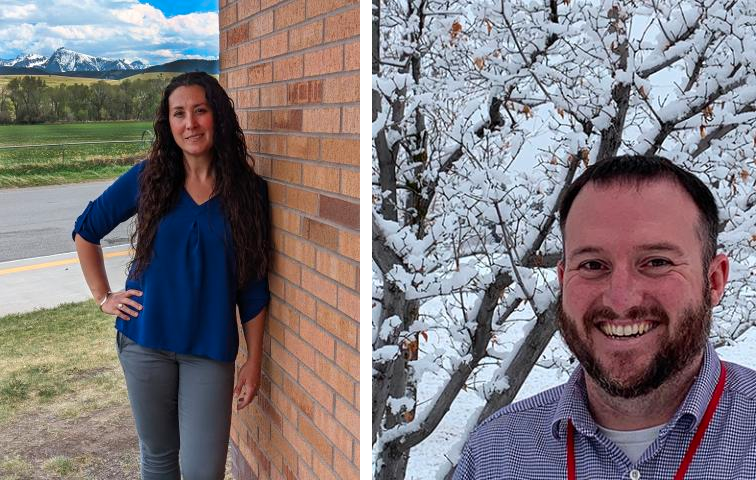Teachers from the NASA-affiliated Montana Learning Center in Helena, Mont. are being lauded as two of the nation’s leading educators.
Fifth grade teacher Chris Pavlovich of East Side Intermediate School in Livingston, Mont., was recently recognized with the prestigious Presidential Award for Excellence in Mathematics and Science Teaching (PAEMST). The PAEMST is the highest honor bestowed by the United States government specifically for K-12 science, technology, engineering, mathematics, and/or computer science teaching. Recipients reflect the best of the expertise and dedication to their profession among the nation’s body of teachers, and demonstrate how outstanding educators can dramatically impact student achievement. The National Science Foundation administers PAEMST on behalf of the White House Office of Science and Technology Policy.
Arlee High School science teacher Bill Stockton is the 2022 Montana Teacher of the Year, and joins a cohort of 56 Teachers of the Year, representing every state and territory across America. The national Teacher of the Year program aims to encourage student success by enhancing teachers’ leadership abilities and classroom creativity. Recipients meet in Washington, DC for further training and to exchange ideas about their innovative approaches to student learning. Stockton teaches high school science on the Flathead Indian Reservation in Northwestern Montana, and the Montana Digital Academy.
NASA’s Northwest Earth and Space Sciences Pathway (NESSP) program has been vital to the Montana Office of Public Instruction’s goal of integrating NASA science into classroom curriculums, particularly in underserved communities.
Pavlovich and fellow teacher Christine O’Shea developed an introductory course on Next Generation Science Standards (NGSS) for other educators across Montana, and later introduced Stockton to the project. The course is a groundbreaking effort to educate teachers about how scientists work, and implement those practices into their K-12 classrooms.
“For NASA to be in the classroom, and not just in informal educational programs, we needed to help teachers understand the 3D of the standards and how that complimented NASA programs,” said Michelle McCarthy, science instructional coordinator at the Montana Office of Public Instruction. Under a 3D teaching model, educators incorporate scientific practices with content already being taught, such as reading, writing, and math.
“Both Chris and Bill are both master teachers and exceptional motivators with a rich depth of knowledge in 3D learning and the integration of Indian Education for All (IEFA) into student learning. Both have been recognized with a number of awards, including for their integration of Indian Education, and these incredible educators have done so much for the teachers, and ultimately the students of Montana,” said McCarthy.
Stockton primarily works with elementary school teachers, whose students are at a naturally curious age, so incorporating scientific thinking into math, reading, and writing is a natural fit. He emphasizes that early awareness of such thinking, while taking advantage of real-life examples, leads to better student preparedness for the more rigorous coursework offered at the junior high and high school levels.
“In Montana, we’re in such a fortunate location. We have a wealth of natural resources and wildlife, so there are a lot of great opportunities here to teach our students about what’s around us,” Stockton said.
“Really, we’re trying to get rid of the border between real life and school. We’re learning through community scientists, experts, engineers, land owners, and business people, and applying what we’re learning to what they’re doing. They’re the models for us, and knowing who they are in our community really helps root us into place,” Pavlovich said.
“At the Montana Learning Center, we are fortunate to have such a talented network of educators who eagerly invest in our students. We are thrilled to see both Bill and Chris, who have both dedicated so much to our programs, recognized at the national level for their outstanding contributions to science education in the state of Montana,” said Ryan Hannahoe, executive director of the Montana Learning Center.
The Montana Learning Center at Canyon Ferry Lake offers youth summer camps in a variety of STEM fields, teacher learning opportunities, and the region’s premier astronomy program, featuring the largest public-use telescope in Montana. Montana Learning Center and Montana State University partner to facilitate NASA’s Northwest Earth & Space Science Pathways in Montana, an outreach effort to strengthen aerospace education and outreach. The Center boasts a picturesque lakeside setting, which is ideal for exploring Montana’s geology and night sky. (NASA Science Activation Award No. 80NSSC22M0006 P00001)
“At the Montana Learning Center, we are fortunate to have such a talented network of educators who eagerly invest in our students. We are thrilled to see both Bill and Chris, who have both dedicated so much to our programs, recognized at the national level for their outstanding contributions to science education in the state of Montana,” said Ryan Hannahoe, executive director of the Montana Learning Center.
Montana Teacher of the Year: https://opi.mt.gov/Educators/Teaching-Learning/Teacher-of-the-Year#10521211787-current-montana-teacher-of-the-year
Award from the White House: https://www.whitehouse.gov/briefing-room/statements-releases/2022/02/08/president-biden-honors-117-individuals-and-organizations-with-highest-u-s-award-for-science-and-mathematics-teachers-and-mentors/
Learn More about NESSP: https://science.nasa.gov/science-activation-team/nessp



































